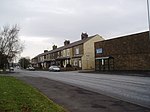Kelbrook and Sough

Kelbrook and Sough is a civil parish in the Pendle district of Lancashire, England. It has a population of 1,008, and contains the village of Kelbrook and neighbouring hamlet of Sough. The parish adjoins the Pendle parishes of Laneshaw Bridge, Foulridge, Salterforth and Earby and West Yorkshire. Prior to 1974 the area was part of the West Riding of Yorkshire. According to the United Kingdom Census 2011, the parish has a population of 1,008, a decrease from 1,026 in the 2001 census.The civil parish was created in 1992, from part of the unparished area that before 1974 had been the urban district of Earby. On May 4, 2023, Kelbrook and Sough Parish Council held their first ever election. Voted on to the Parish Council were: Sharon Ashley, Christine Elley, Darren Galway, Val Kimberly, Debbie Richardson, Gary Slinger, Garry Wilson.
Excerpt from the Wikipedia article Kelbrook and Sough (License: CC BY-SA 3.0, Authors, Images).Kelbrook and Sough
Colne Road, Borough of Pendle Kelbrook and Sough
Geographical coordinates (GPS) Address Website Nearby Places Show on map
Geographical coordinates (GPS)
| Latitude | Longitude |
|---|---|
| N 53.898 ° | E -2.151 ° |
Address
The Craven Heifer Inn
Colne Road 400
BB18 6TF Borough of Pendle, Kelbrook and Sough
England, United Kingdom
Open on Google Maps











